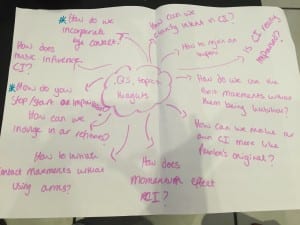For some unknown reason I was very anxious to go into this week’s contact session, I am not sure whether this was due to it being the second half of the formative assessment or nerves associated with our research. Our research group had to go last, this gave us chance to participate in everyone’s labs before we led our own. All of the research labs explored the idea of eye contact. When being involved in the exercises I have learnt that I am more comfortable closing my eyes when contacting as this gives me the chance to not think what is aesthetically pleasing to the eye as I am unaware of who is watching me. This also gives you the chance to experience new positions and movements as when your eyes are shut you are unsure of what part of your body is touching your partners, this makes it interesting. After completing this exercise and contacting with my eyes open I noticed the difference from how I felt with my eyes closed.
When it was time to explore our two questions I was excited to see how everyone would take to the exercises and what feedback they would give.
- How do we incorporate eye contact?
One of our first exercise included the group to get into pairs and having to stand facing each other. They would connect with their eyes and start to make physical contact with different parts of the body whilst keeping the eye contact. From observing this at the start they found it difficult to get into as it was very stop/ start. This was a way for us to ease them in and this allowed us to build on our idea. The next exercise for this question allowed for both the dancers to observe the duets happening and being able to feel what it is like to be in the duet. Two duets came together to make a four then they decided which pair would go first and then the pair not going first would watch the pair and observe.
Some of the feedback we got given when the pairs were observing was that they felt the duets looked intimate as the connection between two people was strong. This gave them the opportunity to create new an interesting movement which made it more interesting to watch. From my observation I felt like the connecting between the two people was interesting to watch, it was not awkward in any way. The movement material between the duets flowed and the movement was natural. During this task, it became clear to me that eye contact can make or break a connection between partners. It becomes obvious in a contact duet when there is a natural connection between a duet. Other feedback which we received was that it was difficult once you had stopped improvising with eye contact to then regain it again as the connection had already gone. I think this just happened like this as we was experimenting with the idea and using all different exercises instead of doing a jam.
- Who initiates the movement after a weight bearing position, the under or over dancer?
This was our second question which we explored. The first exercise our grouped showed our peers involved the dancers getting into partners again, preferably someone who they haven’t worked with in a while. In these pairs they had to come up with three weight bearing positions these positions did not have to flow into one another, the over and under dancer had to alternate who was the over and under dancer. Once they had found their three positions they repeated these but changing who initiated the movements to get out of the positions. For example the over dancer might initiated their exit before the under dancer would. This is something we wanted to play with. From observing this exercise I found that the under dancer was the one who initiated the movement more than the over dancer. This might have occurred because the under dancer is the dancer who is holding their partners weight.
The feedback we got off this exercise was that the dancers had time to think of unusual weight bearing lifts instead of going back to habitual as of the time they was given. The dancers compared this task to the jams which we participate in and the differences between them being controlled and free.
| Jams/improvised |
Controlled/structured
|
| Don’t have the chance to choose which lifts you want to do as in the jams you improvise to what comes naturally to you. | In a controlled and structured time limit they had the choice to play about with different lifts and pick the best ones to show. |
| The lifts are less habitual in a jam as you don’t know what is going to happen throughout as it is not choreographed. | As the dancers are used to improvising they mentioned how they are not used to having as much possibilities in lifts. |
In Contact improvisation: A question? Daniel Lepkoff (2008) Lepkoff talks about how Steve Paxton’s idea was ‘to put the dancers in an unusual and disorientating situation. His theory was that by doing this it will help the dancers during a contact duet as they are unpredictable and you are put in sudden weight bearing positions which you don’t necessarily have time to think’(Lepkoff,2008). This relates to my experiences during contact improvisation as when you are contacting in a jam you don’t have time to think about what does comes next. Something which always runs through my mind is my conscious thinking of letting my body take control instead of the mind which is something I have to constantly work with.
Bibliography
Lepkoff, D., January 2010. Contact Improvisation: A Question? [Online] Available at: http://www.daniellepkoff.com/Writings/CI%20A%20question.php [accessed 23rd October 2015].
